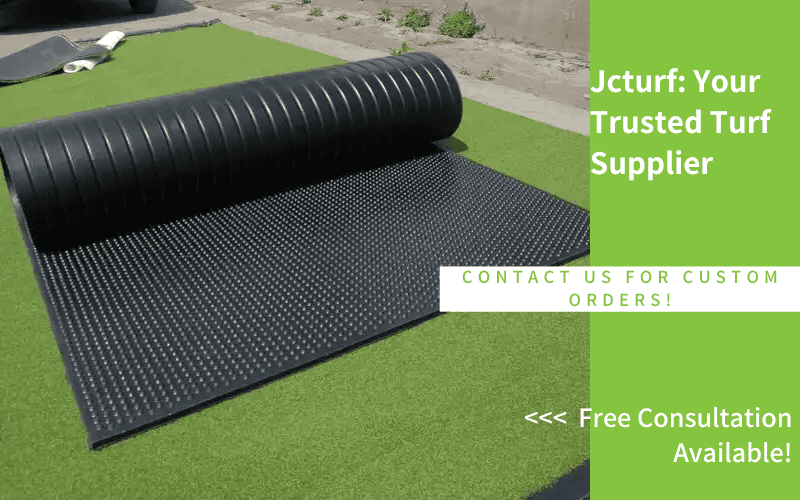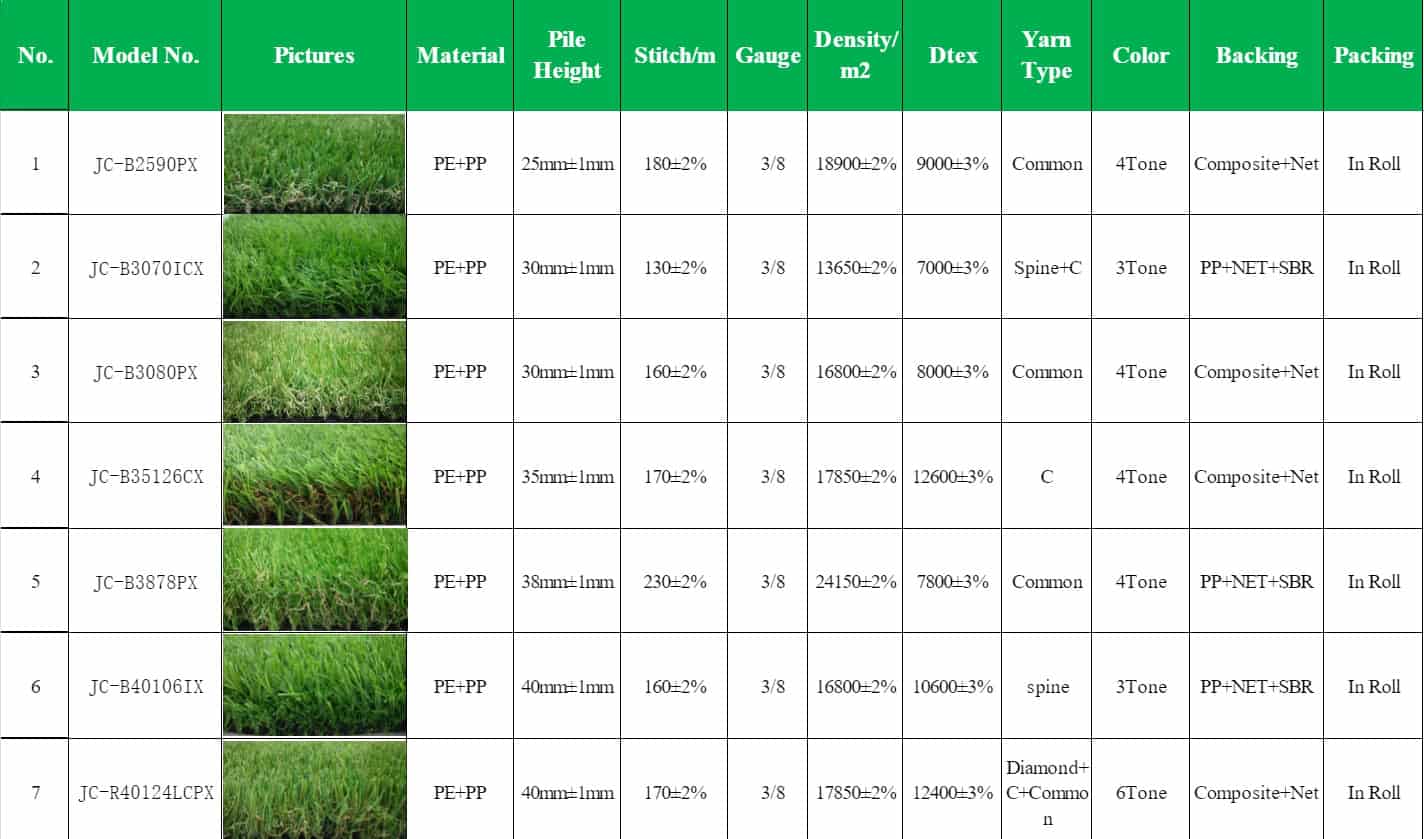Lumpy turf, soggy patches, or sore feet? The culprit might not be your grass—but what’s under it. Artificial grass underlay plays a bigger role than most people realize. In this guide, we’ll walk you through everything you need to know to choose the right base layer for a soft, safe, and long-lasting turf system.
We’ll begin by explaining what underlay is and whether you actually need it. Then, we’ll compare underlay options for different surfaces like concrete, soil, and decking, and break down the best materials—foam, rubber, polyurethane, and recycled blends. You’ll learn how to judge quality, install it properly, and avoid common mistakes. We also cover drainage solutions, safety choices for kids, and the difference between padding and underlay.
By the end, you won’t just know what to buy—you’ll understand why it matters.
What Is Artificial Grass Underlay and Why Does It Matter?
When installing artificial grass, the underlay—sometimes called turf underlayment or padding—is the layer placed between the ground and the synthetic turf. It’s often made from foam, rubber, or other resilient materials designed to support the surface above.
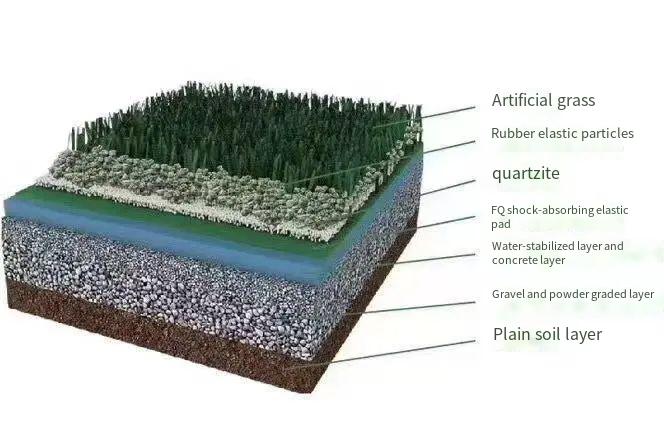
While it might look like an optional step, underlay plays a bigger role than many expect. It helps create a smoother, softer, and more durable surface. Without it, artificial grass may wear down faster, feel hard underfoot, or even drain poorly.
Do You Really Need Underlay for Artificial Grass?
Whether you actually need artificial grass underlay depends on how and where you’re installing the turf. Some situations absolutely call for it, while others may allow you to skip it. In this section, we’ll walk through when underlayment is essential, when it’s not strictly necessary, and what common myths can lead to poor decisions.
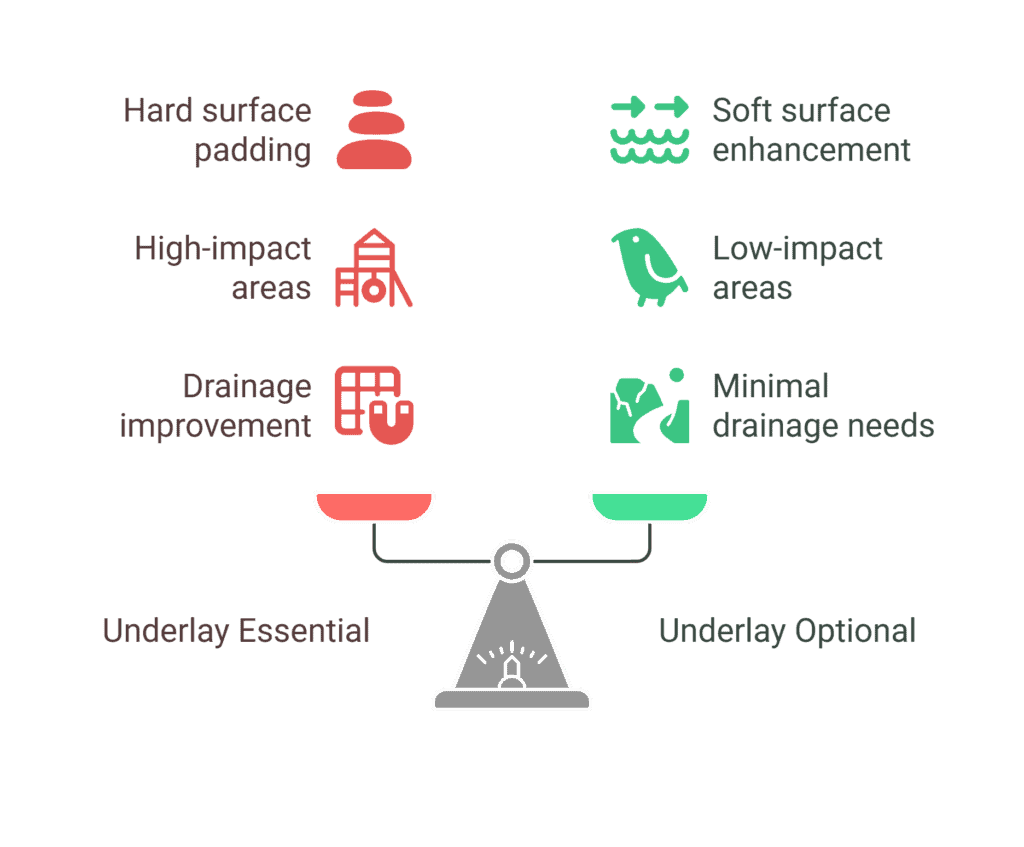
When Underlay Is Essential
If you’re laying artificial grass over concrete, paving, decking, or compacted gravel, an underlay is a must. These hard surfaces offer no natural give, so the padding layer adds comfort, absorbs impact, and helps the turf last longer. It also levels out minor imperfections, preventing visible bumps or gaps.
You’ll also want underlay in areas where shock absorption or drainage is a priority—like playgrounds, pet areas, or yards that get heavy rain. In these cases, a quality shock pad or foam underlayment can make a big difference in performance and safety.
When You Might Not Need It
For turf laid directly over well-prepared soil or a full aggregate sub-base, underlay may not always be necessary. If the surface is already level, free-draining, and lightly cushioned by compacted sand or granite dust, your turf can go straight on top.
That said, even in these setups, adding a thin underlay can still improve comfort and extend turf life—so it becomes more of a “nice to have” than a must.
Common Misconceptions About Underlay
Some people assume underlay is only about softness. In reality, it also:
- Improves drainage
- Extends turf lifespan
- Reduces noise when walked on
- Helps turf look and feel more natural
Others believe it’s only for sports fields or playgrounds, but even residential gardens can benefit—especially in extreme climates or multi-use spaces.
Best Materials for Artificial Grass Underlay
The performance of artificial grass underlay depends largely on the materials used. Whether you’re looking for durability, drainage, softness, or eco-friendliness, choosing the right underlay material makes a big difference. In this section, we’ll look at the most common underlay materials: foam, rubber, polyurethane, and recycled blends—each with their strengths and use cases.
Foam Underlay
Foam is one of the most popular choices for turf installations. It’s lightweight, easy to cut, and offers a soft feel underfoot. Closed-cell foam types resist water absorption, making them suitable for both dry and moderately wet environments. Foam also comes in various thicknesses, giving you more control over comfort and fall protection.
That said, not all foams are equal. Lower-density options may compress over time in high-traffic areas. For lasting performance, go for cross-linked or high-density foam underlays with drainage holes if possible.
Rubber Shock Pads
Rubber underlay is prized for its shock absorption and long-term durability. Made from recycled rubber or vulcanized materials, these pads are excellent for areas where impact resistance matters—like playgrounds or sports zones.
Rubber is heavier and usually more expensive than foam, but it stays stable under heat and foot traffic. It also tends to hold its shape well, making it a solid choice for permanent installations on concrete or tile bases.
Polyurethane (PU) Underlay
Polyurethane underlays are engineered for both flexibility and performance. They’re often used in commercial or high-spec turf systems where comfort and resilience are top priorities.
PU pads are known for their uniform cell structure, which gives them a consistent feel across large areas. They also perform well in wet conditions, draining quickly without breaking down. However, they tend to be pricier than foam or rubber.
Recycled and Eco-Friendly Options
If sustainability is a priority, several manufacturers now offer underlay made from recycled foam, rubber, or mixed polymers. These products aim to reduce landfill waste while still offering solid shock absorption and drainage.
Quality can vary depending on the source material and process, so it’s worth checking performance specs carefully. But for many homeowners, recycled underlay strikes a balance between environmental responsibility and performance.
| Material Type | Key Features | Best For |
| Foam | Lightweight, soft feel, available in various thicknesses | General use on concrete, soil, or decking |
| Rubber Shock Pads | Highly durable, excellent impact absorption, heat-resistant | Playgrounds, sports areas, high-traffic zones |
| Polyurethane (PU) | Flexible, uniform comfort, drains well, premium performance | Commercial turf setups, wet or uneven surfaces |
| Recycled / Eco-Friendly | Sustainable, made from recycled materials, variable quality | Eco-conscious homeowners, standard lawn use |
Best Underlay Options for Different Surfaces
Choosing the right artificial grass underlay depends heavily on the surface you’re working with. Different base types call for different materials, thickness levels, and features. In this section, we’ll go through the best underlay choices for five common surfaces: concrete, soil, decking, hard ground, and pet areas.
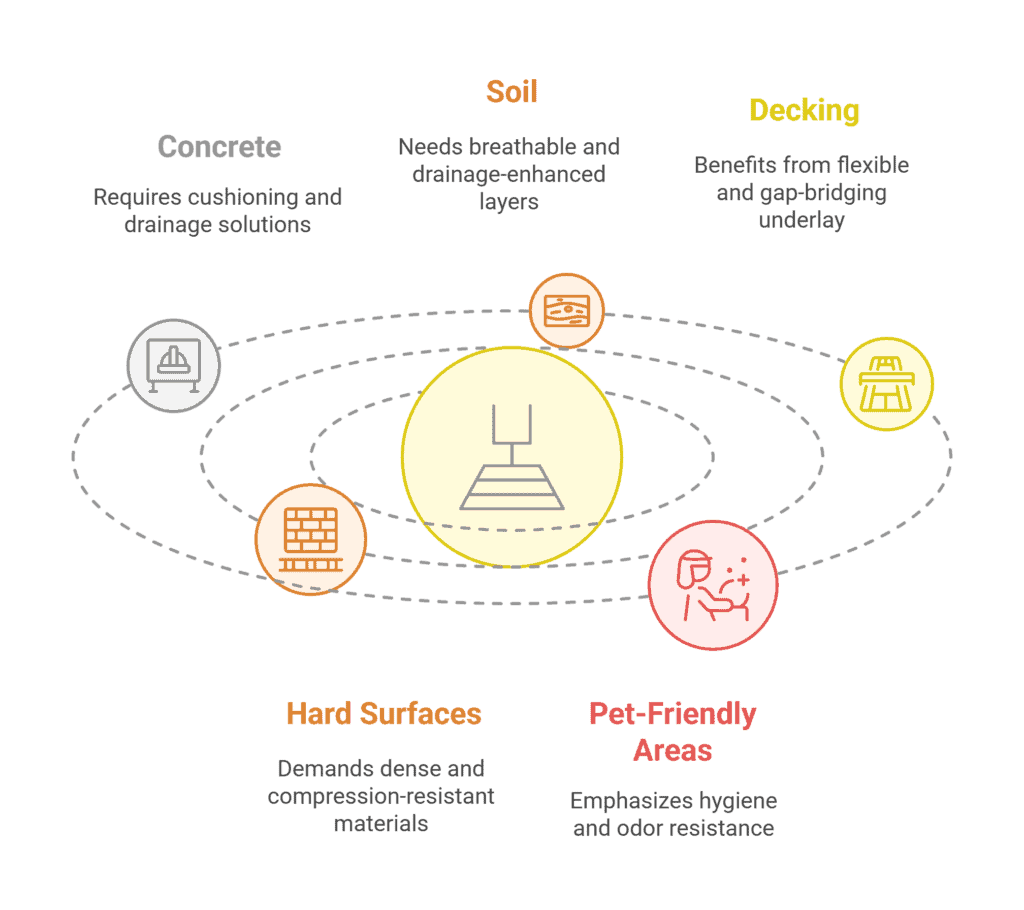
Concrete
Concrete is one of the most unforgiving bases. It’s hard, unyielding, and can quickly wear down your turf if left unprotected. The best choice here is a foam underlay or shock pad, typically around 10–12mm thick. It cushions impact, evens out minor imperfections, and adds a soft feel underfoot. If water drainage is a concern, look for options with perforations or a drainage mat underneath.
Soil or Natural Ground
If you’re laying turf over well-compacted soil or a sub-base like crushed stone, you may not need a thick underlay—but a breathable foam layer can still help. It adds a touch of comfort, protects the turf backing, and smooths out minor dips. In areas with heavy rain, drainage-enhanced underlay is ideal to avoid pooling and muddy spots.
Decking
Wooden decking presents a unique challenge. It’s not level by default and often has gaps. A flexible roll-type underlay, like cross-linked foam, works well to bridge those gaps and create a flat base. The cushioning also reduces impact noise and prevents the turf from sagging into the deck grooves over time.
Hard Surfaces (Paving, Tiles, Gravel)
For surfaces like paving slabs or compacted gravel, go for a dense foam or rubber underlay. These help to level uneven joints and reduce the pressure that wears down turf over time. In high-traffic zones, durability is key—choose underlays rated for compression resistance.
Pet-Friendly Areas
In homes with dogs or other pets, hygiene and drainage become top concerns. Choose an underlay that’s non-absorbent, easy to clean, and odor-resistant. Many pet-specific turf systems pair antimicrobial foam layers with drainage channels to help keep the area dry and fresh.
| Surface Type | Recommended Underlay | Key Benefits |
| Concrete | 10–12mm foam underlay or shock pad with drainage | Cushions impact, levels surface, improves drainage |
| Soil / Natural Ground | Breathable foam underlay (optional, for comfort and drainage) | Smooths minor dips, protects turf backing, helps drain water |
| Decking | Flexible roll-type foam underlay (bridges gaps, reduces sagging) | Bridges deck gaps, reduces noise, prevents sagging |
| Hard Surfaces (Paving, Tiles, Gravel) | Dense foam or rubber underlay (compression resistant) | Levels joints, protects against wear and pressure |
| Pet-Friendly Areas | Antimicrobial, non-absorbent underlay with drainage channels | Odor control, easy to clean, stays dry and fresh |
Key Features to Look for in Artificial Grass Underlay
Not all artificial grass underlay is made the same. The right turf padding should do more than just sit under your grass—it should actively support its look, feel, and performance. Below are four essential features to pay attention to when choosing an underlay: drainage capability, thickness, durability, and compatibility with your surface and turf type.
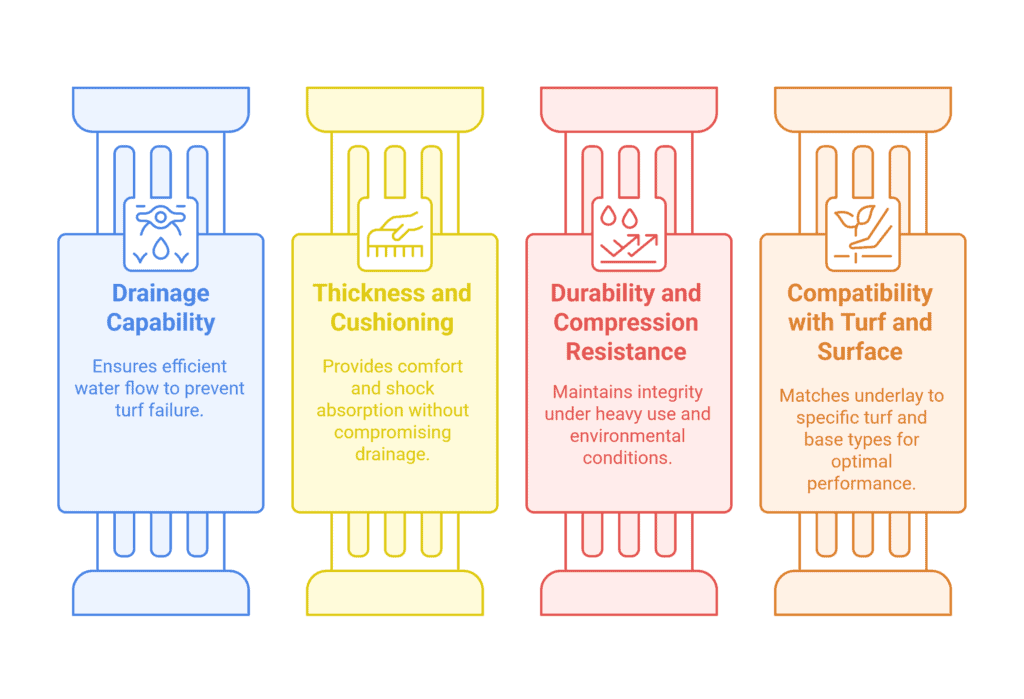
Drainage Capability
If water can’t escape efficiently, even the best turf will fail. A good underlay should allow rainwater to flow through quickly, especially in wet climates or yards without a slope. Look for underlay with built-in perforations or grooves that direct water away from the surface. For heavy rainfall areas, pairing the underlay with a permeable base layer is even more important.
Thickness and Cushioning
The thickness of your underlay directly affects turf comfort, drainage, and durability. Most products range from 10mm to 25mm. Use 10mm for patios or low-traffic areas, and 20–25mm for zones needing shock absorption, such as playgrounds or pet runs.
Avoid going too thick—excess padding can block drainage, raise edges, and trap moisture. Choose a thickness that offers comfort without compromising drainage or stability.
Durability and Compression Resistance
Artificial grass installations are meant to last years. A weak underlay can compress underfoot traffic, causing dips and wrinkles. Choose a product rated for outdoor use with proven resistance to wear, UV exposure, and temperature changes. High-density foam or rubber materials usually perform better in high-traffic zones like walkways or patios.
Compatibility with Turf and Surface
Some underlays work well on soil but slide on smooth decking. Others pair best with short-pile turf, while some support thick, heavy blades. Always match your underlay to both your base surface and turf type. If you’re unsure, consult the turf supplier for recommendations—many offer matched underlay solutions for best results.
How to Install Artificial Grass Underlay Properly
Installing underlay correctly is key to turf performance, comfort, and drainage. Here’s how to do it right, whether you’re working on soil, concrete, or decking.
Step 1: Prepare the Base Surface
Soil or natural ground:
- Remove grass and 2–3 inches of topsoil.
- Add and compact crushed stone or granite dust as a drainage base.
- Use a plate compactor to level and solidify the surface (target 90–95% compaction).
- Maintain a slight slope (1–2%) for water runoff.
Concrete, paving, or decking:
- Clean thoroughly to remove dirt, moss, and debris.
- Repair cracks or uneven areas.
- Ensure a dry, level surface. Add a drainage layer if needed.
Step 2: Add a Weed Barrier (Optional)
- Use a permeable weed membrane on soil to block growth from below.
- Secure with pins every meter.
- Not needed on hard surfaces unless weeds or moisture are concerns.
Step 3: Lay the Underlay
- Choose a suitable underlay: foam for general use, rubber for impact zones, or antimicrobial for pets.
- Roll it out flat across the area.
- Trim to fit using a utility knife.
- Align any drainage perforations with the slope or drainage channels.
Step 4: Secure the Underlay
On hard surfaces:
- Apply outdoor adhesive around the perimeter or under the full layer as needed.
- Use turf tape for seams. Avoid blocking drainage holes with glue.
On soil or aggregate:
- Fix the underlay with U-pins or turf staples every 30–50 cm.
- Overlap edges slightly and tape seams if required.
Step 5: Inspect and Flatten
- Walk across the underlay to press it down evenly and release air pockets.
- Check for wrinkles, raised edges, or uneven seams.
- Trim any excess along edges and fixtures.
Common Mistakes to Avoid
- Poor base compaction leads to soft spots and surface shifts.
- Wrong underlay choice (e.g., smooth foam on decking) causes slippage.
- Over-gluing seals drainage holes and traps moisture.
- Unsecured edges or seams can cause turf to ripple over time.
Expert Tips
For pet areas, use breathable underlay that dries quickly and resists odor.
Ask your turf supplier about compatibility between underlay and turf, especially for heavy-use or commercial spaces.
Test water flow before turfing to confirm drainage efficiency.
Align perforations with natural slope or direction of runoff.
Can You Glue Artificial Grass to the Underlay?
Yes, but only when it’s necessary.
Gluing artificial grass to the underlay is useful for hard surfaces like concrete or paving, where shifting is a concern. In these cases, apply outdoor-grade adhesive that’s compatible with your underlay material (foam, rubber, or PU).
However, gluing isn’t ideal on soil or decking. It can block drainage and trap moisture. On these surfaces, it’s better to secure turf with U-pins, turf tape, or weighted edges.
For DIY installations, gluing only the perimeter is a smart compromise—it holds the edges while allowing the center to remain breathable. Avoid applying too much glue or covering drainage holes.
In short, use glue only when the surface, usage, and permanence require it—not by default.
Artificial Grass Underlay for Drainage: What Works Best?
Good drainage is critical in artificial grass systems, and the underlay plays a major role. Choose products with built-in perforations, grooves, or mesh-style channels to let water flow through quickly—especially in areas with heavy rainfall.
Foam and rubber underlays designed for drainage direct water down to the sub-base, reducing pooling and mold risk. But drainage doesn’t depend on underlay alone. Pair it with a permeable base, like compacted granite, limestone chippings, or coarse sand, to help water move downward.
Avoid placing drainage-friendly underlay on dense clay or flat concrete—water will get trapped. If the area has no natural slope, grade the base slightly or install a French drain.
In short, effective drainage comes from a full system: breathable underlay, porous base, and turf with a perforated backing.
Artificial Grass Underlay for Playgrounds and Kids
For playgrounds and children’s play areas, underlay isn’t just about comfort—it’s a critical safety component. A proper turf padding should absorb impact, provide stability, and comply with playground safety standards.
The best choice is a shock pad system made from high-density foam or rubber. These pads are specifically designed to reduce injury from falls and should be CFH-certified (Critical Fall Height), ensuring compliance with standards used in schools and public spaces.
Recommended underlay thickness ranges from 25mm to 50mm, depending on the height of the play equipment. However, thicker doesn’t always mean safer—performance depends on whether the turf and underlay have been tested and certified as a complete system.
Drainage matters too. Kids play year-round, and waterlogged surfaces can be slippery. Choose an underlay with perforations or breathable materials that allow quick water runoff and drying.
If safety is your top priority, request test reports or safety certifications from your supplier—especially for toddler areas or where climbing structures are present. The right underlay not only protects children but also gives parents and facility owners lasting peace of mind.
Is There a Difference Between Turf Underlay and Padding?
Yes—while often used interchangeably, “underlay” and “padding” refer to different aspects of artificial grass systems.
Turf underlay is a broad term for any layer placed between the base surface and synthetic turf. It can be made from foam, rubber, or polyurethane, and typically helps level the ground, support drainage, and add light cushioning.
Padding (often called a shock pad) specifically emphasizes impact absorption. It’s commonly used in high-impact areas like playgrounds, sports fields, and rooftops, where fall protection is required. These products usually meet safety standards such as Critical Fall Height (CFH) compliance.
In residential or light-use areas, the same material may serve both roles. But in regulated or high-risk spaces, padding needs to be performance-tested for its shock-absorbing capabilities.
Ultimately, what matters is not the label but the specs: check thickness, density, and drainage design to match the product to your project.
| Feature | Turf Underlay | Padding (Shock Pad) |
| Main Purpose | Leveling, drainage support, basic comfort | Fall protection, shock absorption |
| Common Materials | Foam, rubber, polyurethane | High-density foam or rubber |
| Focus | Base preparation, turf stability | Safety, impact resistance |
| Typical Use Cases | Lawns, patios, decorative areas | Playgrounds, sports fields, rooftop spaces |
| Marketing Terms | “Underlay”, “Underlayment” | “Shock Pad”, “Turf Padding” |
| Are They Interchangeable? | Sometimes, depending on usage | Not in regulated safety zones |
How to Choose the Right Underlay for Your Needs
Choosing the right artificial grass underlay depends on three key factors: your budget, how the space will be used, and whether you’re installing it yourself or hiring help. Here’s how to decide quickly and confidently.
Balance Budget and Performance
If you’re on a tight budget, start with a basic foam underlay around 10mm thick. It offers decent comfort and is easy to work with. For high-performance needs, such as playgrounds or sports turf, invest in certified shock pads—even if they cost more.
Match the Use Case
Not every area needs the same support. Patios and balconies need drainage-focused underlay. Kids’ play areas need cushioning. Pet zones benefit from antimicrobial and odor-resistant options. Think about who’s using the space—and how.
DIY or Professional Installation
Doing it yourself? Choose underlay that’s lightweight, easy to cut, and doesn’t require adhesives. For professional installs, heavier rubber or multi-layer systems can give better results—but may need expert handling.
Sustainable and Eco-Friendly Underlay Solutions
Eco-friendly artificial grass underlay is typically made from recycled foam, rubber, or mixed polymer materials. These options reduce landfill waste and carbon footprint while still offering essential features like drainage and light cushioning.
While performance may vary slightly between batches, many recycled underlays now match standard foam in durability and softness. They’re a smart choice for residential lawns, especially when paired with permeable turf.
When choosing a green solution, ask suppliers about post-consumer content, recyclability, and safety certifications. You don’t have to trade performance for sustainability anymore—just pick carefully.
Can I Reuse Old Underlay When Replacing Turf?
You can reuse the old underlay if it’s in good condition—flat, undamaged, and still elastic. Check for mold, compression, or tears before reusing. If any part looks degraded, it’s best to replace it to avoid long-term issues.
Final Tips Before Buying Artificial Grass Underlay
Before you buy artificial grass underlay, take a moment to double-check a few essentials. A smart purchase avoids rework and ensures your turf performs as expected.
- Know your base surface. Concrete, soil, and decking need different support and drainage.
- Check product specs. Look for thickness, material type, drainage design, and usage rating.
- Ask for a sample. Feeling the material helps judge softness, density, and flexibility.
- Plan the full system. Consider how your base, underlay, turf, and edging will work together—not just as separate parts.
Spending five extra minutes checking details now can save five hours of regret later.

